Test – Corsair Carbide 400Q: Review |Specs | CPU | Hashrate | Set-up| Config | Pros & Cons – Corsair offers a wide variety of products on the computer components market, the brand started a long time ago with memory modules and has widely extended with power supplies, boxes, AIO water cooling and so on
. Today I will offer you the latest of the brand’s boxes, I named the Carbide 400! 2 models are available, one with a glass to clearly see the configuration (the “C”) and one specially designed for silence (the “Q”), it is the latter which will be the subject of the test. On the program a compact chassis but in ATX format and capable of accommodating imposing components, all lined with noise-canceling foam wherever possible in order to control noise pollution as much as possible.
Offered at a price of around € 110, the Carbide 400 will however have a hard time facing all the other boxes on the market, let’s see what it has in store for us!
Specification: Hashrate – Corsair Carbide 400Q
| Corsair Carbide 400Q | |
|---|---|
| Motherboard compatibility | Mini ITX, Micro ATX, ATX |
| Materials | Steel and Plastic |
| Available colors | Noir |
| Number of berries | 2 x 3,5″ / 2.5″ 3 x 2.5″ |
| Fan location (s) | 3 x 12 cm or 2 x 14 cm in front 1 x 12 cm behind 2 x 12/14 cm above |
| Fan (s) supplied | 1 x 14 cm in front 1 x 12 cm behind |
| Expansion slots | 7 |
| Front connectors | 2 x USB 3.0 2 x Jack 3,5 mm |
| Graphics card length | 37 cm maximum |
| CPU cooling height | 17 cm maximum |
| Watercooling compatibility | Radiator Up to 360 mm at the front Radiator up to 240 mm above Radiator up to 120 mm at the rear |
| Additional features | 2 removable hard drive cages Foam on the side panels, front Covers for the power supply and the drive cage inside Cover + foam above instead of the optional fans Dust filters in front and under the power supply |
| Dimensions | 42.5 (l) x 46.4 (H) x 21.5 (L) cm |
| Weight | 8.2 kg |
| Guarantee | 2 years |
| Price | ~ 110€ TTC |
Seeing the technical sheet, the Corsair Carbide 400Q does not lack assets, especially in terms of its size, with its 46.4 cm high, 21.5 cm wide and especially 42.5 cm deep it is not the lowest nor the narrowest of the boxes on the market but its depth will allow it to fit easily in most locations. The weight on the other hand does not necessarily reflect this compactness, but that is not a bad thing because with 8.2 kg it will inevitably be built almost entirely in steel, and will therefore be logically solid.
It accepts motherboards in ATX format, and of course smaller versions such as micro ATX and mini ITX. In addition to the ATX motherboard, the internal components will have the right to be overweight, 37 cm long for the graphics card and 17 cm high for the cooler, there is no doubt that the Carbide 400 is intended for a configuration of the type ” gamer ”.
These contained dimensions and increased component compatibility, however, adversely affect the storage capacity, we are entitled to 3 slots for 2.5 ″ disks but only 2 for 3.5 ″ disks, however the 5.25 ″ slots are completely absent here. However, this will remain sufficient for the vast majority of users, storage and reader / writer fans will have to go their way!
Ventilation on the other hand was not left out by Corsair, 2 x 14 cm or 3 x 12 cm fans at the front, 1 x 12 cm at the back and 2 x 12/14 cm above, enough to keep any market configuration cool. Originally, the brand provides us with 1 14 cm fan at the front and 1 12 cm fan at the rear.
In addition to all this Corsair has added a few little extras to its Carbide 400Q, version “silence” requires there is foam on the front face, on the side panels and above. A cover is available above to limit noise pollution if fans are not installed. 2 other removable covers are also present in front of the power supply and the hard drive cage for a cleaner look.
Offered at a price of around 110 € the technical characteristics are for the moment encouraging for the future, let’s see what it gives!
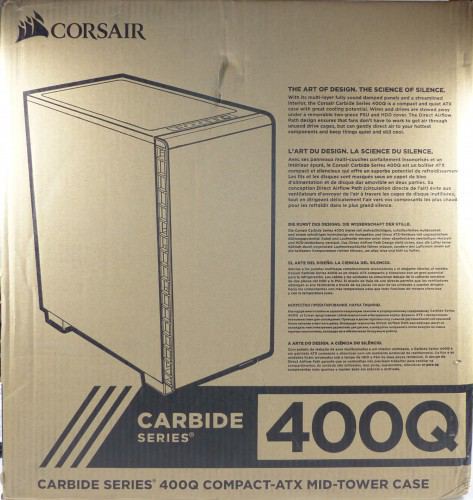
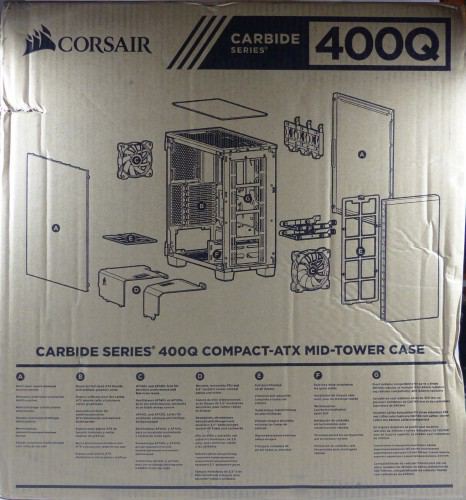
The cardboard could not be more sober, on the front there is a drawing of the case accompanied by the logo of the brand, the model as well as a small screed on the strong points of the Carbide 400Q. At the back an exploded view of the case as well as a listing of all the elements.
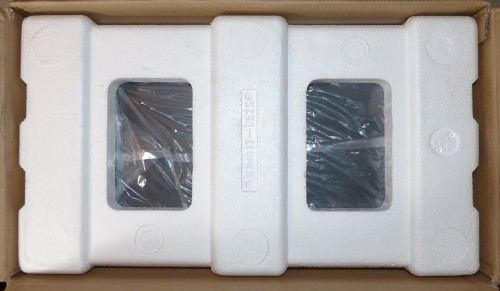
When opening the box we fall on the box in its plastic bag caught between 2 polystyrene molds to ensure the safest possible transport.
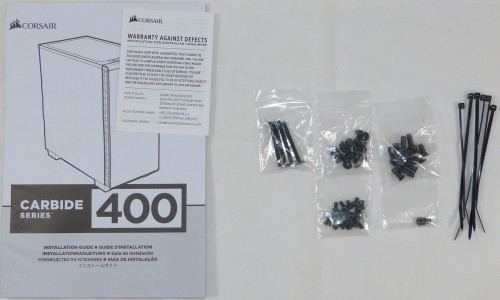
Corsair delivers with the Carbide 400Q everything you need to assemble the configuration, the manual, a warranty leaflet, some plastic cable ties and of course the necessary screws. There is nothing superfluous here, but the essential is there.
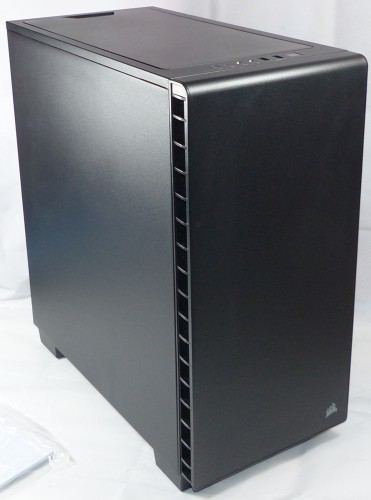
Voici la bête! Une chose est sûr Corsair a joué la sobriété avec son dernier boitier. Tout est ici noir et la peinture est de très bonne qualité. Lors de la manipulation on sent que le Carbide 400Q est solide, un bon point. Comme on peut le voir les aérations sont placées comme la quasi totalité des boitiers orientés silence du marché, à l’avant et sur les côtés, elle sont cependant larges et très peu restrictives, cela aidera à une bonne ventilation.
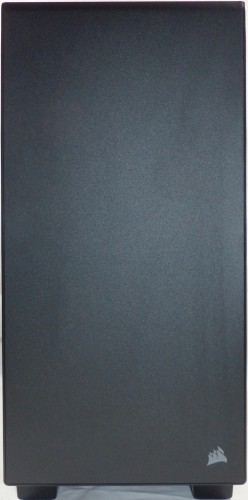
Que dire de la face avant? Pas grand chose si ce n’est que Corsair aurait eu du mal à faire plus sobre, seul le logo de la marque en bas à droite vient troubler tout ce noir. A noter que contrairement à la majorité des constructeurs Corsair a recouvert la façade d’une plaque en acier ce qui la rend solide et de meilleur qualité que du simple plastique.
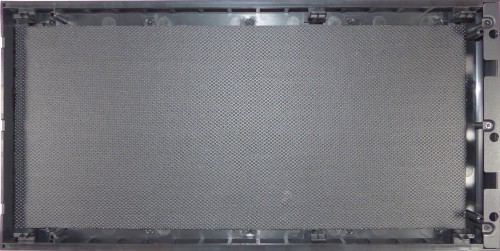
At the back of the facade there is a large foam plate which will help to dampen noise pollution and also vibrations.
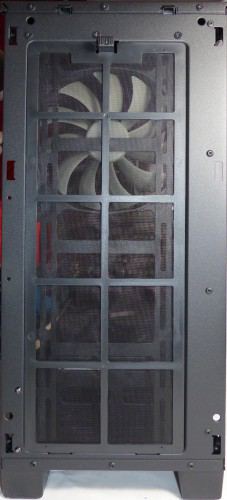
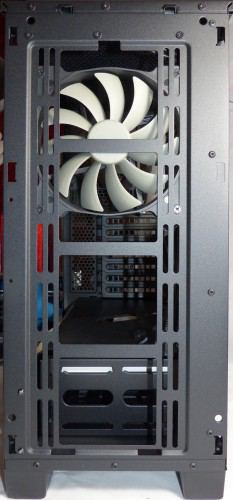
A large magnetic dust filter is present in front of the locations of the fans at the front, restrictive grid point here and the air can pass very easily. The original 14 cm fan is placed in alignment with the processor, which will help the temperatures of the latter but if hard drives are installed in the bottom cage it will not benefit from the airflow, just can be fixed by placing the fan elsewhere however.
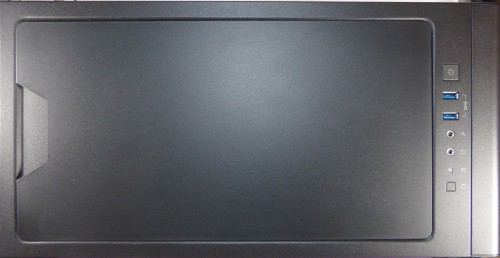
Above again sobriety is required, a large cover in front of the locations of the fans as well as the connections.

The connection consists of 2 USB 3.0 ports and 2 3.5 mm jack ports for a microphone and a headset, the minimum union nowadays, 2 other USB 3.0 ports would not have been refused. Of course there is also the power and reset buttons as well as an LED for hard disk activity.
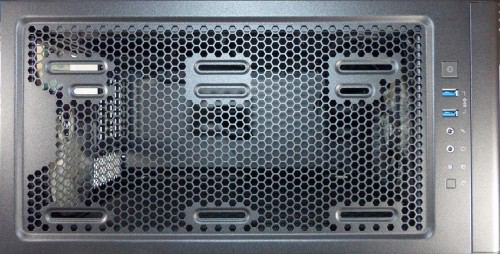
Under the cover a large honeycomb grille, this will allow to add ventilation in case the original fans are not sufficient, or to install a water-cooling radiator with a maximum length of 280 mm.

Under the still magnetic cover of foam, Corsair decided to put as much as possible, and that’s not a bad thing!
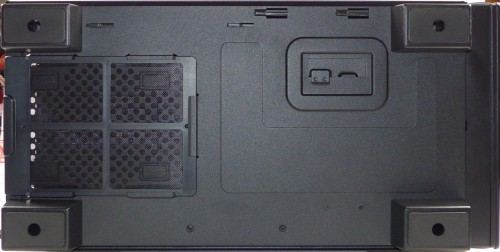
En dessous on trouve 4 larges pieds en plastique équipés d’une bonne quantité de caoutchouc, cela aidera à l’isolation des vibrations du boitier sur la surface sur laquelle il réside. Un filtre anti-poussière amovible est également présent en dessous de l’alimentation.
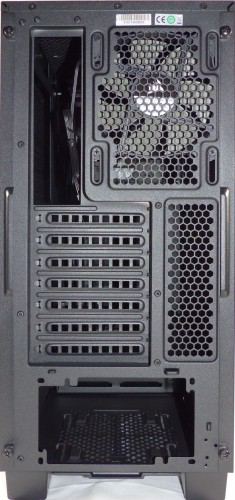
A l’arrière on est face à du grand classique, une grille en nid d’abeille capable d’accueillir un ventilateur de 12cm (qui peut être ajuste en hauteur au besoin), des équerres d’extensions ajourées et amovibles, une grille de ventilation en nid d’abeille à côté de ces derniers ainsi que bien entendu l’emplacement de l’alimentation. A noter que les vis à main des 2 panneaux latéraux restent en place une fois dévissés, au moins on ne les perdra pas!
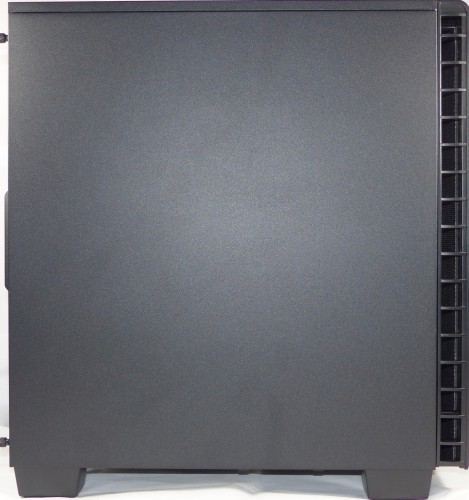
The sides are like the rest of the case, completely sober! Large solid metal panels (even if quite thin) as well as a large air intake at the front.
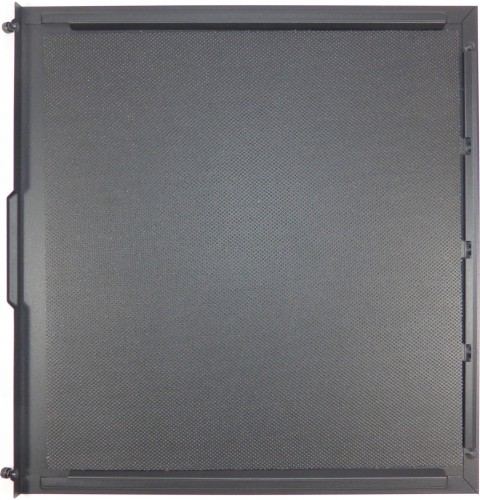
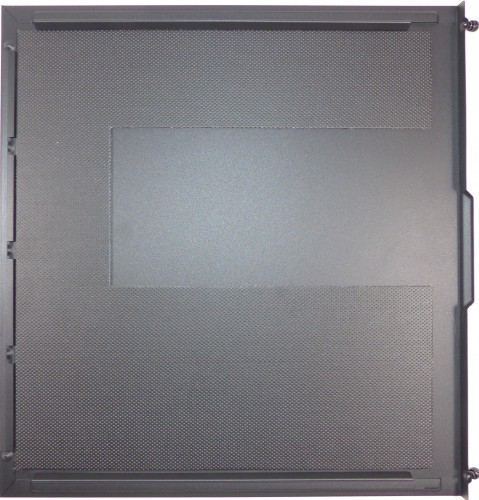
Inside these panels foam has been installed, on the back side of the motherboard (the photo on the left) the foam completely covers the panel while the components side (photo on the right) Corsair has deliberately left a portion not covered. Why? It’s simple, with a very high heatsink installed it could have touched the foam, by removing it at this right there we gain a few precious millimeters, everything has been thought out on the Carbide 400Q!
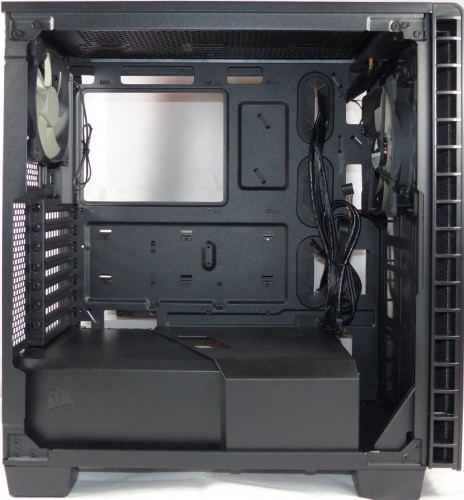
Here is the interior of the beast! As we can see despite the dimensions of the machine the space is rather nice inside. The lack of 5.25 ″ slot leaves the field free for fans and allows a little aeration of the bowels. The power supply as well as the hard drive cage are hidden by 2 removable covers (which are screwed from the back), let’s see what it looks like without them:
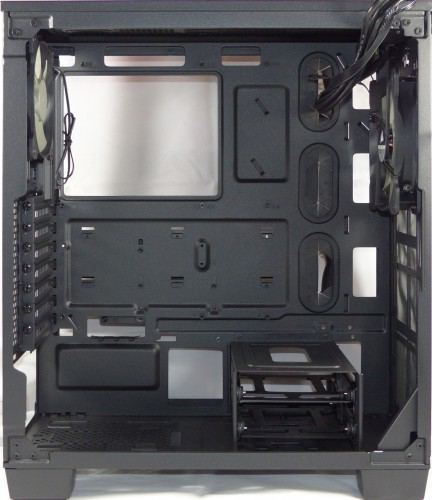
We can see a little better! The build quality is very good, everything is perfectly adjusted, there is absolutely nothing to say about the finish of the beast. Many openings are present for the passage of the cables at the back of the motherboard, the spacers are already in place, the assembly should not pose the slightest problem.
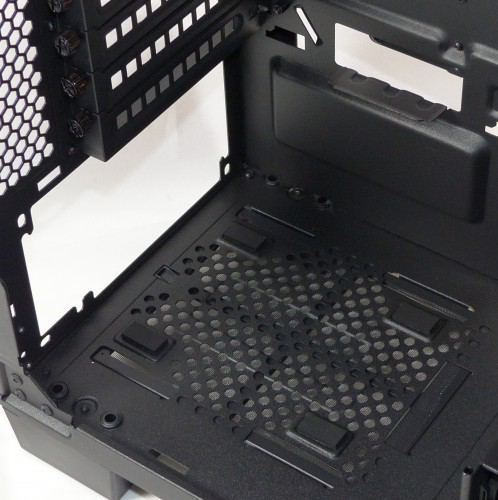
The power supply is based on 4 rubber pads, which will further limit the vibrations (although very contained) due to the fan.
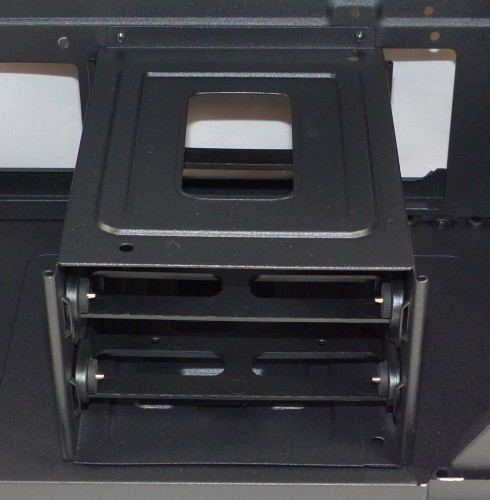
The hard disks cage is removable, it can contain 2 disks in 3.5 ″ or 2.5 ″ format, the carriages are fitted with silentblocs, once again to limit vibrations.
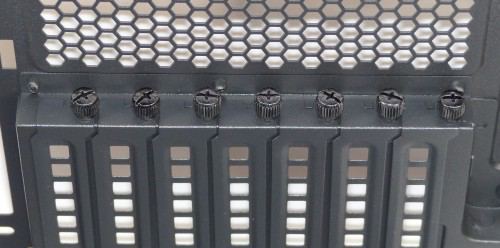
The extension brackets are perforated, removable and fixed by hand screws, a great classic and ventilation will be done without worries there, a honeycomb grid is also present and will also facilitate ventilation.
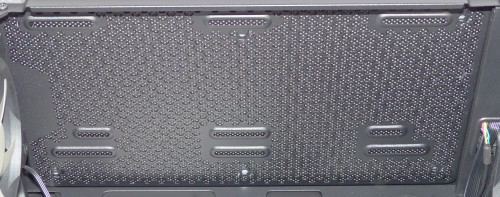
The ventilation grid above will accommodate either fans or a water-cooling radiator, if the need arises.
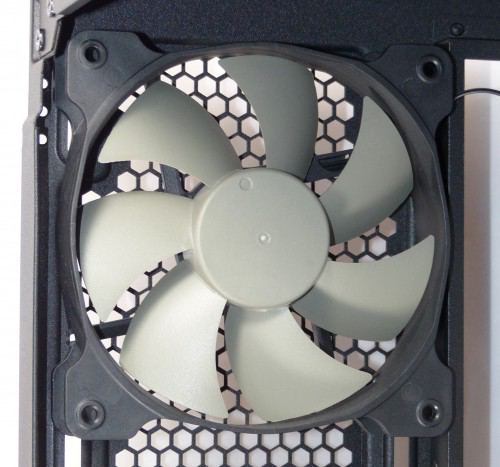
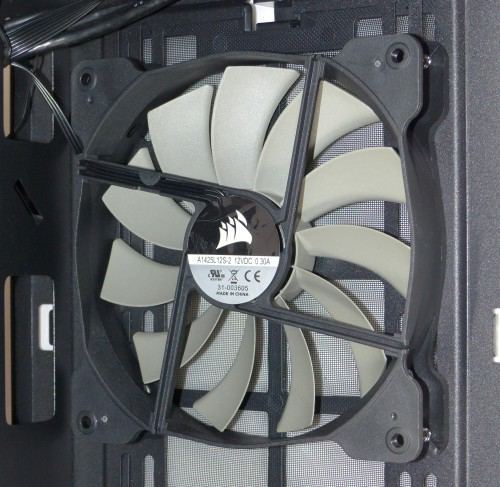
The fans supplied are the brand’s AF models, an AF14L running at a maximum speed of 1150 RPM in the front and an AF12L 1100 RPM in the rear, operation should be rather quiet.
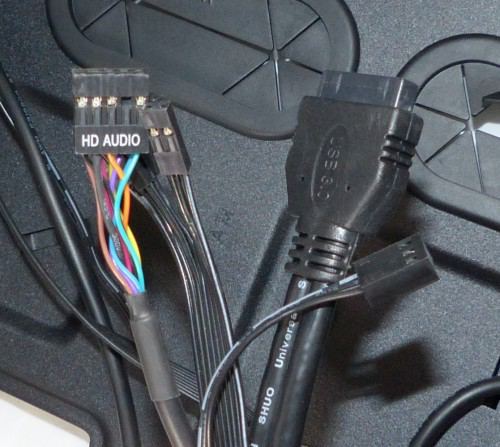
The connectors of the various ports and buttons on the front, the cables are all black.
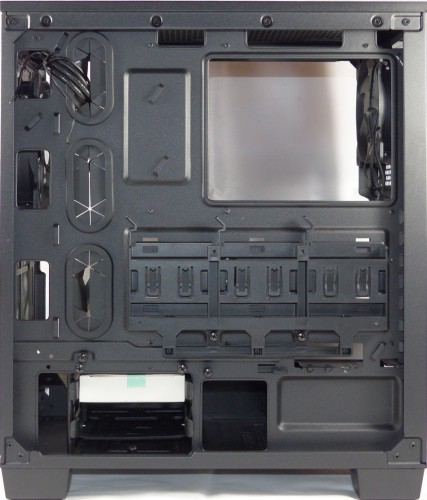
At the back of the motherboard, in addition to the various openings for the passage of cables, there is a cage capable of accommodating 3 2.5 ″ peripherals, and access to the cage for 3.5 ″ peripherals. The space available for the passage of the cables should be sufficient for an easy assembly, only the locations can pose problems, it will be necessary to pass the cables in general around.
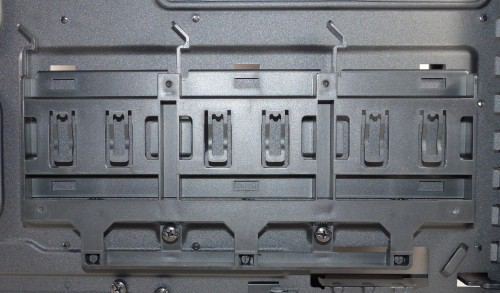
The plastic cage can accommodate 3 2.5 ″ devices, they slide from the top and are retained by a locket. If these locations are not used then it is also possible to remove the cage via 2 hand screws.
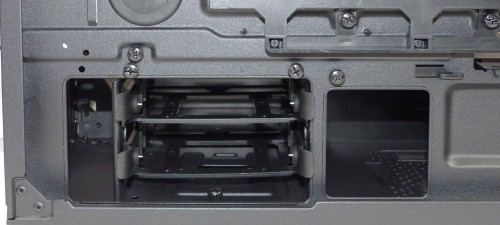
The 3.5 ″ hard drives are installed from the rear, in the dedicated cage. As I said above it is also possible to remove it via the 2 hand screws above.
The configuration used during the tests is as follows:
A rather large configuration therefore due to its huge cooler and the 3 slots taken by the graphics card. The Corsair Carbid 400Q will be tested once with 5V fans and once in 12V with only the SSD connected. Another test will take place at 5V with the Raptor hard drive connected, it being literally hell in terms of its vibrations, which will allow you to see the box’s capacity to contain them.
The assembly in the Carbide 400Q went overall well, the whole structure is rather solid and we are not afraid of twisting everything when handling. The part where the components are installed being quite spacious there are no particular problems to install everything. Let’s see what this gives without the power supply / hard drive cage caches:

As we can see all the components breathe, even the big Noctua NH-D15 and the graphics card taking 4 slots. The airflow is not impeded and it clearly shouldn’t have any temperature concerns.
On the other hand, compactness means that the space between the motherboard and the top ventilation grid is quite confined, it is not easy to connect the 8-pin CPU cable with a cooler already installed (it is the case in many boxes anyway). The installation of fans / watercooling radiators can be quite complicated if, for example, the memory modules are too high they could conflict, you have to calculate your shot coup
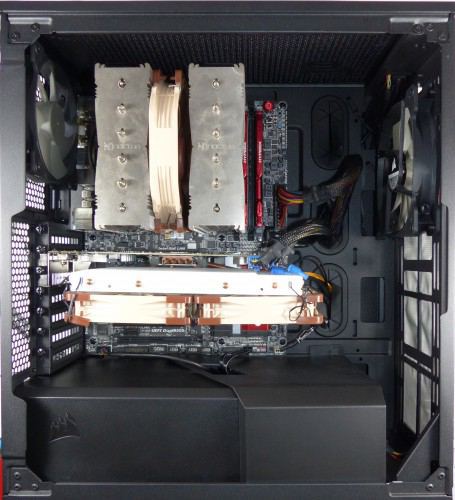
With the covers everything is even cleaner, on the other hand a tip, start the configuration well and be sure that everything works before putting them in place, if a cable must be added it will be necessary to disconnect the cables from the LEDs / buttons on the front and audio, remove the covers, plug in the cable, and put everything back in place.
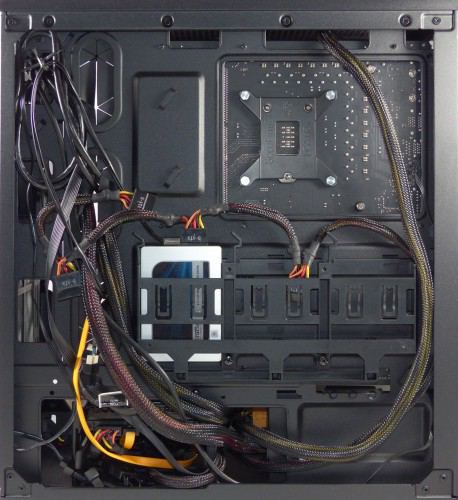
At the rear, however, you have to be a little vigilant, the space is correct but you should not make big blocks of cables under penalty of having to untangle them. The thing which is a little more annoying concerns the cage of the 2.5 ″ drives, the power cable will have to go around to plug them in from the top (as in the photo), it’s not a big deal but you have to be careful .
In order to test the box, I will carry out an OCCT Power Supply test for 30mins and then take the temperatures of the main components such as the processor (average of the 4 cores), the motherboard, the graphics card as well as the hard drive.
Regarding noise pollution, I will proceed as in the file on silent PCs namely 1 statement in front, right, left, rear and above.
The Corsair Carbide 400Q will face the case used for the silent pc backrest, the Corsair Carbide 300R modified for the needs of the same backrest as well as the NZXT S340 SE (which is its direct competitor, the internal design being largely similar), NZXT H440 , be quiet! Silent base 800, Cooler Master Silencio 652S, as well as the Fractal Design Define R5. The choice of boxes is not random, all these boxes are rather silent so the Corsair Carbide 400Q will have a lot to do!
Repos
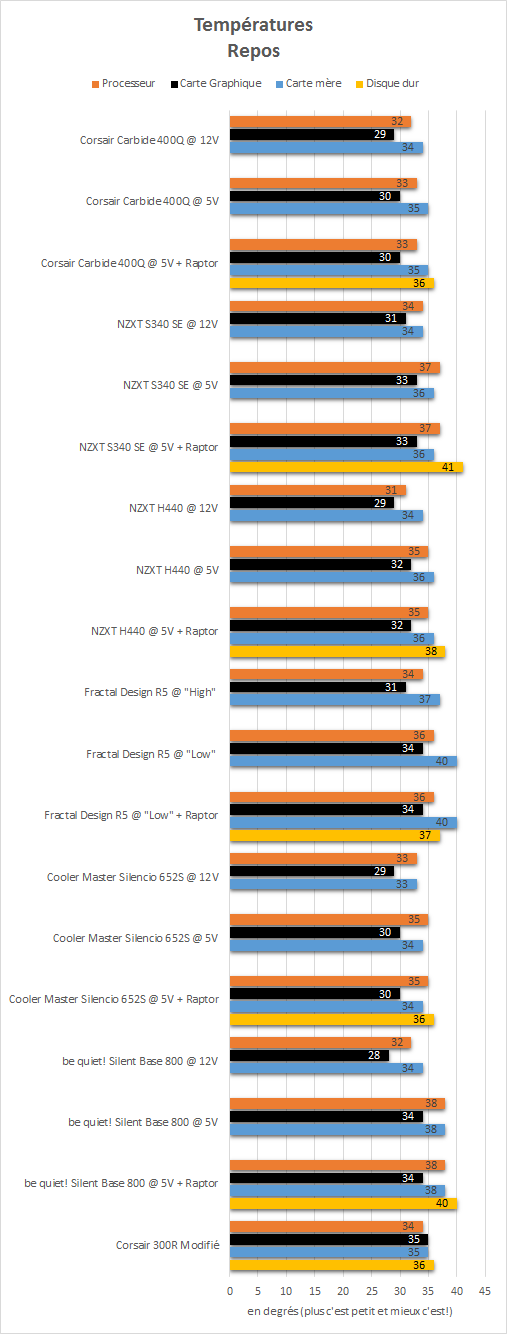
The temperatures at rest in the Carbide 400Q are very good, with the fans supplied at 5V the processor stagnates at 32 °, the graphics card at 30 ° and the motherboard at 34 °. Once the voltage is increased to 12V and therefore the fans are running at full speed, we gain a small degree on all readings by going to 32 °, 29 ° and 34 ° for the processors, graphics card and motherboard respectively.
One thing is certain, the very open design, whether in terms of the air intakes or the internal layout, makes the components happy.

Ambient sound level: 31dB
It is here that we expect it, the Carbide 400Q is intended to be used for a silent PC, it must be admitted that the results go in this direction!
With a maximum of 35 dB at the rear once the fans are set to 5V it is clear that the configuration is silent, here we are at the level of an NZXT H440 or even a Fractal Design R5 (even if the latter is quieter. front), and that’s no small feat!
Once the Raptor hard drive is installed, and always with the 5V fans, the vibrations of the disc propagate to the carcass and slightly raise the general sound level, even if in the end it remains very contained. The Carbide 400Q manages to handle these vibrations better than many boxes on the market, even if they are not completely erased. It goes without saying that with a more classic hard drive there shouldn’t really be any problems.
With the fans at maximum, and therefore supplied with 12V, the sound level does not rise very much, to cap at a small 38 dB at the rear, so it is possible for someone who is not a purist to let them run thoroughly while keeping a discreet configuration.
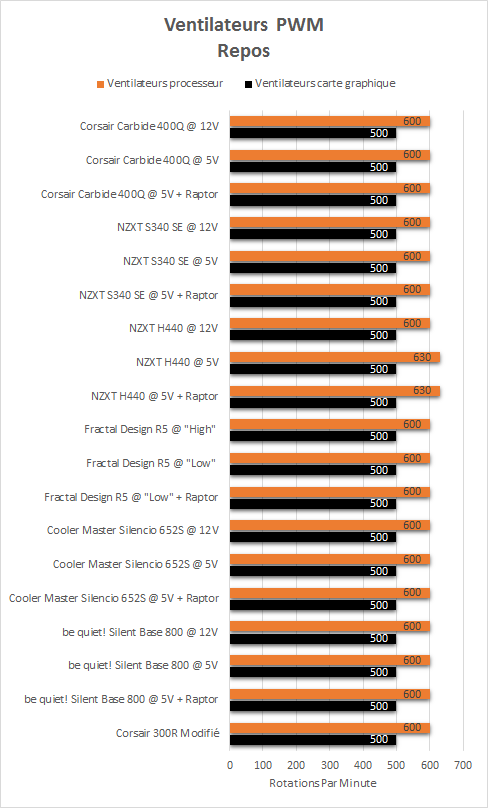
Nothing to report here, as the vast majority of cases in the test, the fans remain at their base RPM, ie 600 RPM for the processor and 500 RPM for the graphics card.
Charge
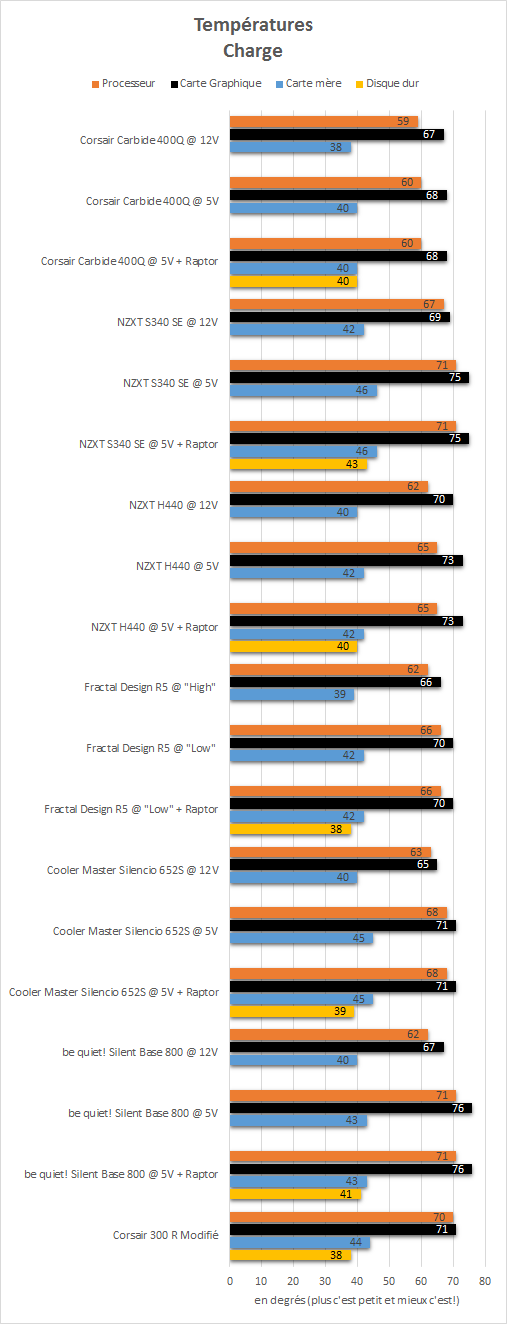
In load we have confirmation of the good performance observed at rest, indeed with a maximum of 60 ° for the processor, 67 ° for the graphics card and 38 ° for the motherboard it is clear that the components inside the Carbide 400Q are well cooled.
Once the fans are set to the minimum and seen that the sound level and the speed of the fans are not very different from the 12V, the temperatures do not change too much. The processor stagnates at 60 °, the graphics card at 68 ° and the motherboard at 40 °, that’s all good!
We can say that the very open design works here very well, the components are well cooled.
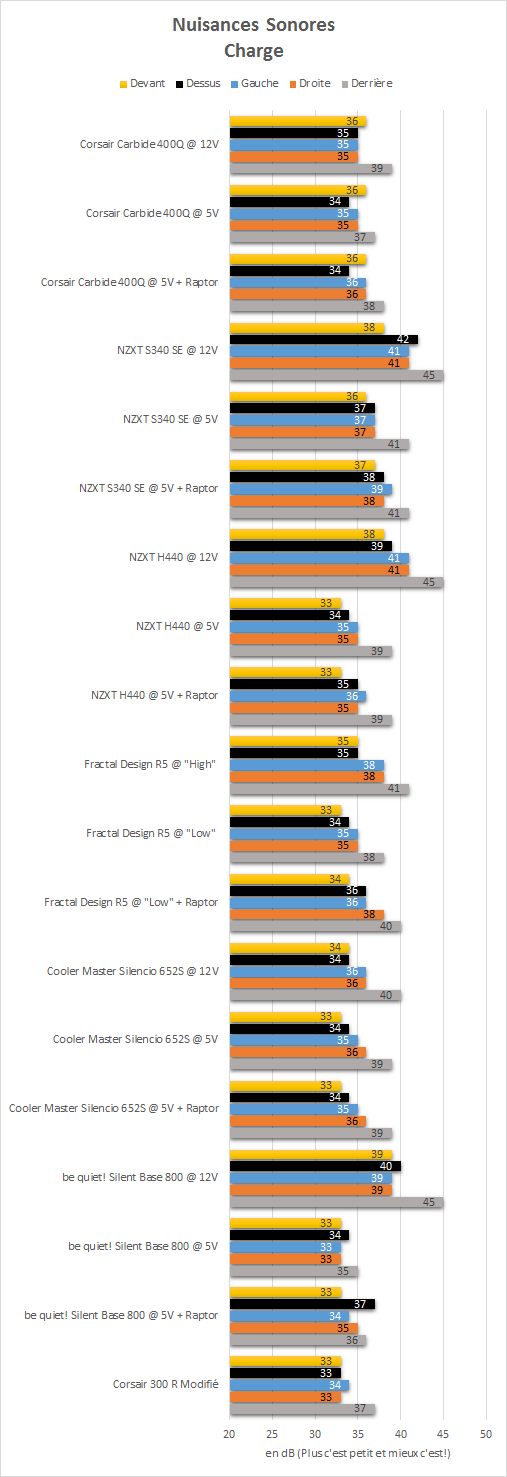
Ambient sound level: 31dB
The good results are confirmed here, a maximum of 39 dB at the rear when the fans are fully charged, places it very well in the comparison. Once the fans are at a minimum, there are not a lot of differences and we fall to 38 dB with the raptor installed and 37 dB without it, the 2 values being noted at the rear.
Even if it does not reach the level of a Fractal Design Define R5 there is clearly nothing to complain about in terms of noise pollution to the Cardibe 400Q, the open design largely favoring the air flow but leaves s ‘escape a little noise (especially at the front), this will however remain silent for 99% of users.
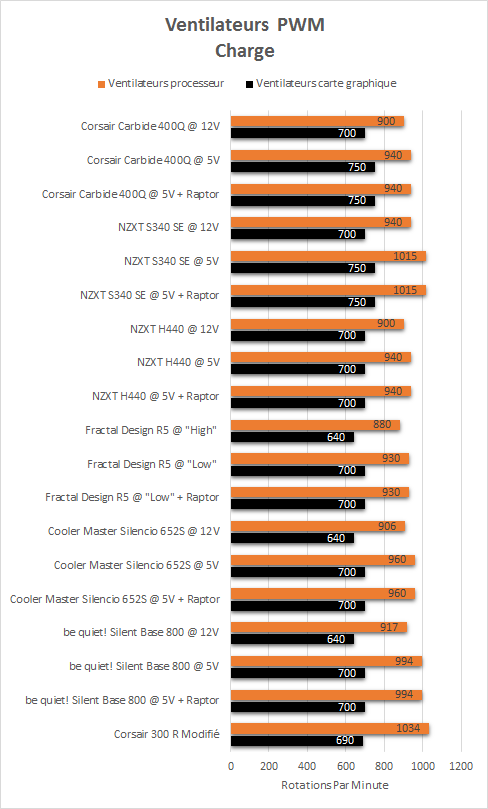
The RPMS of the fans managed automatically by the components do not vary much compared to the other boxes, we arrive at a maximum of 940 RPM for the fans of the processor in 5V (against 900 RPM in 12V) and 750 RPM (700 RPM in 12V) for graphics card fans, given the noise pollution under load, this is not surprising.
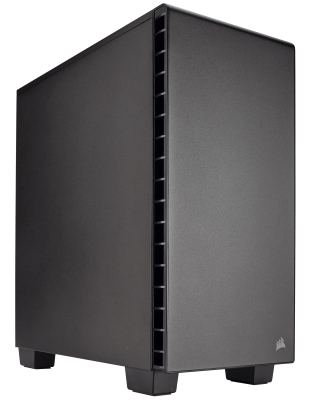
Here we are at the end of this test, what about the Corsair Carbide 400Q?
Corsair returns to the charge with a case which is of an exemplary finish and of an equally excellent manufacturing quality. The internal layout is very well thought out, the space gives free rein to the larger components without the slightest worry, in addition to having an air flow very little hindered by different elements, which results in high performance. level while keeping a very low sound level thanks to the 2 rather silent fans even at maximum.
Corsair has also thought of a lot of small details, like the dust filters and the magnetic top fan cover, foam wherever it is possible to put it (in addition to having a piece cut out on the panel which is facing the components to have the maximum space available for the cooler), rubber pads to damp the vibrations of the power supply, no restrictive grid for the ventilation on the front etc. It is clear that the Carbide 400Q has been work.
In addition to being able to accommodate large configurations the box is very compact, which will result in a saving of space (especially in depth) rather nice. On the other hand this saving of space and the possibility of installing bulky components there entails a small defect, the assembly! Indeed even if it only has to be done once, the assembly is tedious, but only at the back of the case, the 2.5 ″ disc cage entails an obligation to pass the cables on its sides, mixed with this is enough space but just enough at the back of the motherboard and you will have to be patient to put everything in and close the side panel.
Offered at a price of around 110 € the Corsair Carbide 400Q is a box that has many advantages even if it would have been even more interesting with around 15 € less, it will be able to accommodate and cool a gamer config without eyebrows and all in silence (if the installed components are silent of course).
Advantages
- Build quality
- Silence
- Performances
- Compact
Disadvantages
- A bit high price
- A bit tedious assembly
A big thank you to Aurélien from Corsair who allowed me to do this test.















